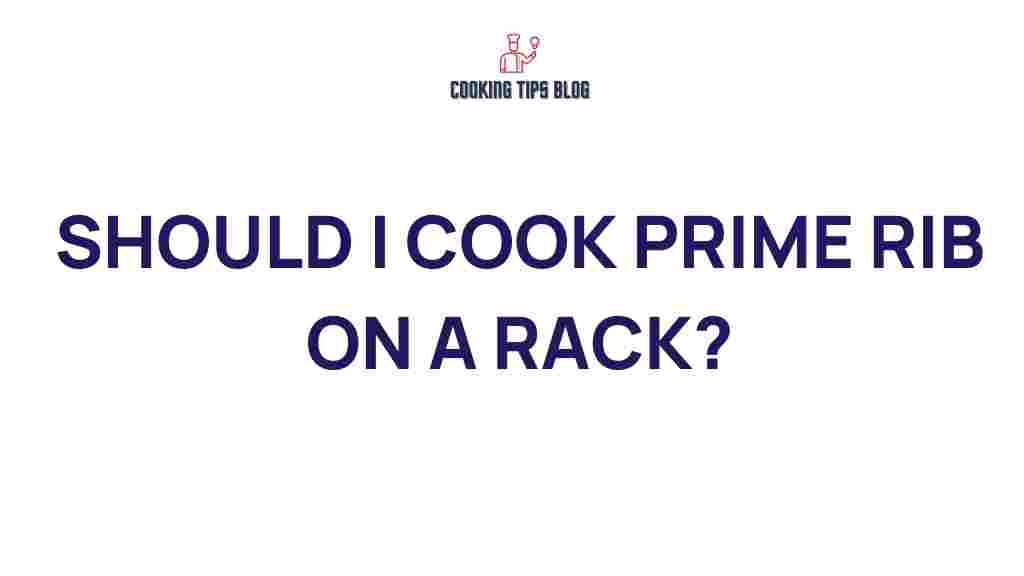Should You Cook Prime Rib on a Rack? Discover the Best Method!
When it comes to preparing a stunning roast for special occasions, prime rib holds a prestigious place on the dining table. The tender, flavorful meat is a favorite among many, but questions often arise about the best way to cook it. One of the most common queries is whether you should cook prime rib on a rack. In this article, we will explore this question in detail and help you discover the best method to achieve a juicy and delicious prime rib.
Understanding Prime Rib
Before diving into the cooking methods, let’s first understand what prime rib is. Prime rib, also known as standing rib roast, is a cut of beef from the rib section. This cut is known for its marbling, which contributes to its tenderness and rich flavor. It’s often served during holidays and special gatherings, making it essential to cook it correctly for the best experience.
Why Use a Rack?
Cooking prime rib on a rack offers several benefits:
- Even Cooking: A rack elevates the meat, allowing heat to circulate all around, resulting in a more evenly cooked prime rib.
- Better Browning: Elevating the roast helps achieve a beautiful crust while preventing it from sitting in its own juices.
- Reduced Sogginess: Cooking on a rack prevents the bottom of the prime rib from becoming soggy, which can occur when it is placed directly in a roasting pan.
While these benefits are significant, some prefer not to use a rack, believing that the juices from the meat enhance the flavor. So, let’s delve deeper into whether you should cook prime rib on a rack or opt for an alternative method.
Best Methods for Cooking Prime Rib
1. Cooking Prime Rib on a Rack
Using a rack is often considered the best method for cooking prime rib. Here’s a simple step-by-step process:
- Ingredients:
- 1 prime rib (approximately 5-7 bones)
- Salt and pepper
- Garlic powder, rosemary, or your favorite herbs (optional)
- Preparation:
- Remove the prime rib from the refrigerator and let it sit at room temperature for about 2 hours.
- Preheat your oven to 450°F (232°C).
- Season the prime rib generously with salt, pepper, and other seasonings.
- Cooking:
- Place the prime rib on a rack in a roasting pan.
- Roast in the preheated oven for 20 minutes.
- Reduce the oven temperature to 325°F (163°C) and continue cooking until the desired doneness is reached (about 1.5-2 hours for medium-rare).
- Use a meat thermometer to check the internal temperature (125°F or 52°C for rare, 135°F or 57°C for medium-rare).
- Resting:
- Remove the prime rib from the oven and tent it with foil.
- Let it rest for at least 20-30 minutes before carving. This allows the juices to redistribute.
2. Cooking Prime Rib Without a Rack
While cooking prime rib on a rack is widely recommended, some cooks prefer not to use a rack. Here’s how you can do it:
- Preparation: Similar to the first method, allow the meat to come to room temperature and season it well.
- Roasting:
- Preheat the oven to 450°F (232°C).
- Place the prime rib directly in a roasting pan without a rack.
- Roast for 20 minutes, then lower the temperature to 325°F (163°C) and continue cooking until your desired doneness.
- Resting:
- Allow the meat to rest as you would in the first method.
Comparing the Two Methods
Here’s a quick comparison between cooking prime rib on a rack versus without one:
| Method | Pros | Cons |
|---|---|---|
| On a Rack | Even cooking, better browning, reduced sogginess | Requires a rack |
| Without a Rack | Simple setup, more flavorful juices | Can result in uneven cooking, sogginess |
Cooking Time and Doneness Guide
To achieve the perfect prime rib, it’s crucial to know the ideal cooking times and temperatures:
- Rare: 120°F (49°C) – 125°F (52°C) – About 15 minutes of resting after cooking.
- Medium-Rare: 130°F (54°C) – 135°F (57°C) – About 20 minutes of resting after cooking.
- Medium: 140°F (60°C) – 145°F (63°C) – About 25 minutes of resting after cooking.
- Medium-Well: 150°F (65°C) – 155°F (68°C) – About 30 minutes of resting after cooking.
- Well Done: 160°F (71°C) and above – About 35 minutes of resting after cooking.
Troubleshooting Tips
Even with the best intentions, things can go wrong while cooking prime rib. Here are some common issues and solutions:
- Prime Rib is Overcooked:
- Use a meat thermometer next time to ensure you are cooking to the desired doneness.
- Consider using a low and slow method for more control.
- Prime Rib is Undercooked:
- Return it to the oven for a little longer, checking every 10-15 minutes.
- Make sure your oven temperature is accurate.
- Uneven Cooking:
- Ensure the prime rib is at room temperature before cooking.
- Consider rotating the roasting pan halfway through cooking.
Conclusion
So, should you cook prime rib on a rack? The answer leans towards yes, as cooking on a rack promotes even cooking and a beautifully browned crust. However, if you prefer to cook without a rack, you can still achieve delicious results. Ultimately, it’s about personal preference and what works best for you.
By following the methods and tips outlined in this article, you can confidently prepare a prime rib that will impress your family and friends. Whether you choose to use a rack or not, the key is to keep an eye on the temperature and allow the roast to rest before serving.
For more tips and recipes, check out our cooking guide or explore expert advice from sources like the American Culinary Federation.
Happy cooking!
This article is in the category Tools and created by Cookingtipsblog Team
